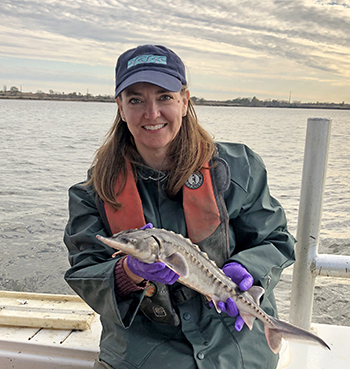Delaware • New Jersey • Pennsylvania
New York • United States of America
 |
| DRBC Executive Director Kristen Bowman Kavanagh with an Atlantic Sturgeon. This activity was conducted under a NOAA National Marine Fisheries Service ESA Permit No. 19255-01, issued to Ian Park, Fisheries Biologist, DNREC Division of Fish and Wildlife. |
Atlantic sturgeon, Acipenser oxyrinchus, belong to a category of ancient bony fishes, which may live up to 60 years, reach lengths up to 14 feet and weigh over 800 pounds.
Atlantic sturgeon are anadromous, which means they are born in freshwater, like the Delaware River, live in the ocean until they reach maturity and return to the river in which they were born to spawn (lay their eggs).
In the Delaware River, they spawn in the freshwater portion of the estuary, on the river's bottom. Juveniles will spend several years in the river before moving out to the Atlantic Ocean.
After spawning, sturgeon will return the ocean; they can make multiple spawning runs during their lifetimes.
Delaware River sturgeon were once the largest population on the Atlantic Coast. They were very popular for their eggs. In the late 1800s, Philadelphia was considered the "caviar capital of North America;" subsequent over-fishing, habitat loss and water quality issues led to their decline.
In 2012, the federal government listed all five distinct population segments of Atlantic sturgeon as endangered or threatened; the Delaware River is part of the "New York Bight" and is considered endangered.
Mortality from shipping traffic strikes, impaired habitat and water quality all threaten current populations.
While recent Delaware River Basin-specific surveys have indicated some spawning success, additional research is needed for future predictions on species recovery.
Improving Water Quality for Atlantic Sturgeon
Today, the Delaware River Estuary supports resident and migratory fish populations, thanks to significant improvements in dissolved oxygen levels. But, oxygen sags are still documented around Philadelphia in the summer months (July and August). This is the area that Atlantic sturgeon prefer for their nursery grounds; while tidal, these waters are considered freshwater.
The reproduction and early life stages of fish species are generally more sensitive to dissolved oxygen levels, meaning these sags in dissolved oxygen can play a critical role in the survival rate and/or growth rate of young sturgeon.
The DRBC performed a multi-year technical study to determine the feasibility of improving dissolved oxygen levels in this part of the Delaware River Estuary to better support fish populations.
- Learn more: A Pathway for Continued Restoration: Improving Dissolved Oxygen in the Delaware River Estuary
Did You Know?
- Sturgeon have been around since the time of the dinosaurs.
- Sturgeon have five rows of bony plates, called scutes, instead of scales.
- Despite being a large fish, sturgeon primarily feed on marine worms, shrimp, and small bivalves and fishes.
- They are bottom-feeders, rooting for and locating food using their snout and barbels, or whiskers.
- Sturgeon are travelers; one tagged sturgeon recorded 900 miles in one summer.
State Agency Information
- Atlantic States Marine Fisheries Commission: Atlantic Sturgeon
- Delaware Department of Natural Resources and Environmental Control (DNREC): Atlantic Sturgeon
- DNREC: Report Sightings of Atlantic Sturgeon (in Del., N.J. or Pa.)
- New Jersey Division of Fish and Wildlife: Atlantic Sturgeon Research in Delaware Bay continues in 2021
- Pennsylvania Fish and Boat Commission: Sturgeons
Federal Agency Information
Other
Copyright © Delaware River Basin Commission,
P.O. Box 7360, West Trenton, NJ 08628-0360
Phone (609)883-9500; Fax (609)883-9522
Thanks to NJ for hosting the DRBC website